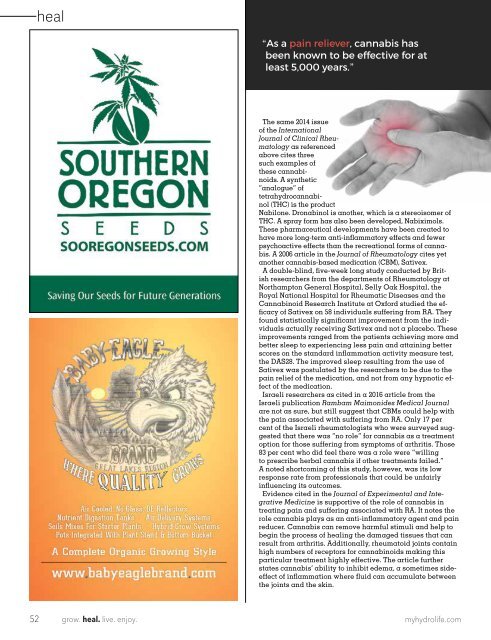Hydrolife Magazine August/September 2016 (USA Edition)
Welcome to the third edition of the new Hydrolife. At this point, all we can say is “wow”. The response from readers, industry professionals and those who use cannabis to heal themselves has blown away all expectations. When we started Hydrolife with a medicinal cannabis theme, our intent was to connect growers, medical practitioners, patients and health enthusiasts by providing information related to this powerful plant. As we continue to do that, it is becoming apparent that passion in the medicinal cannabis revolution runs deep.
Welcome to the third edition of the new Hydrolife. At this point, all we can say is “wow”. The response from readers, industry professionals and those who
use cannabis to heal themselves has blown away all expectations. When we started Hydrolife with a medicinal cannabis theme, our intent was to connect
growers, medical practitioners, patients and health enthusiasts by providing information related to this powerful plant. As we continue to do that, it is becoming apparent that passion in the medicinal cannabis revolution runs deep.
Create successful ePaper yourself
Turn your PDF publications into a flip-book with our unique Google optimized e-Paper software.
heal<br />
“As a pain reliever, cannabis has<br />
been known to be effective for at<br />
least 5,000 years.”<br />
The same 2014 issue<br />
of the International<br />
Journal of Clinical Rheumatology<br />
as referenced<br />
above cites three<br />
such examples of<br />
these cannabinoids.<br />
A synthetic<br />
“analogue” of<br />
tetrahydrocannabinol<br />
(THC) is the product<br />
Nabilone. Dronabinol is another, which is a stereoisomer of<br />
THC. A spray form has also been developed, Nabiximols.<br />
These pharmaceutical developments have been created to<br />
have more long-term anti-inflammatory effects and fewer<br />
psychoactive effects than the recreational forms of cannabis.<br />
A 2006 article in the Journal of Rheumatology cites yet<br />
another cannabis-based medication (CBM), Sativex.<br />
A double-blind, five-week long study conducted by British<br />
researchers from the departments of Rheumatology at<br />
Northampton General Hospital, Selly Oak Hospital, the<br />
Royal National Hospital for Rheumatic Diseases and the<br />
Cannabinoid Research Institute at Oxford studied the efficacy<br />
of Sativex on 58 individuals suffering from RA. They<br />
found statistically significant improvement from the individuals<br />
actually receiving Sativex and not a placebo. These<br />
improvements ranged from the patients achieving more and<br />
better sleep to experiencing less pain and attaining better<br />
scores on the standard inflammation activity measure test,<br />
the DAS28. The improved sleep resulting from the use of<br />
Sativex was postulated by the researchers to be due to the<br />
pain relief of the medication, and not from any hypnotic effect<br />
of the medication.<br />
Israeli researchers as cited in a <strong>2016</strong> article from the<br />
Israeli publication Rambam Maimonides Medical Journal<br />
are not as sure, but still suggest that CBMs could help with<br />
the pain associated with suffering from RA. Only 17 per<br />
cent of the Israeli rheumatologists who were surveyed suggested<br />
that there was “no role” for cannabis as a treatment<br />
option for those suffering from symptoms of arthritis. Those<br />
83 per cent who did feel there was a role were “willing<br />
to prescribe herbal cannabis if other treatments failed.”<br />
A noted shortcoming of this study, however, was its low<br />
response rate from professionals that could be unfairly<br />
influencing its outcomes.<br />
Evidence cited in the Journal of Experimental and Integrative<br />
Medicine is supportive of the role of cannabis in<br />
treating pain and suffering associated with RA. It notes the<br />
role cannabis plays as an anti-inflammatory agent and pain<br />
reducer. Cannabis can remove harmful stimuli and help to<br />
begin the process of healing the damaged tissues that can<br />
result from arthritis. Additionally, rheumatoid joints contain<br />
high numbers of receptors for cannabinoids making this<br />
particular treatment highly effective. The article further<br />
states cannabis’ ability to inhibit edema, a sometimes sideeffect<br />
of inflammation where fluid can accumulate between<br />
the joints and the skin.<br />
52<br />
grow. heal. live. enjoy.<br />
myhydrolife.com




![Hydrolife Magazine December 2017/January 2018 [CANADIAN EDITION]](https://img.yumpu.com/59790088/1/190x247/hydrolife-magazine-december-2017-january-2018-canadian-edition.jpg?quality=85)
![Hydrolife Magazine December 2017/January 2018 [USA EDITION]](https://img.yumpu.com/59790042/1/190x247/hydrolife-magazine-december-2017-january-2018-usa-edition.jpg?quality=85)
![Hydrolife Magazine October/November 2017 [Canada Edition]](https://img.yumpu.com/59493562/1/190x247/hydrolife-magazine-october-november-2017-canada-edition.jpg?quality=85)
![Hydrolife Magazine October/November 2017 [USA Edition]](https://img.yumpu.com/59493548/1/190x247/hydrolife-magazine-october-november-2017-usa-edition.jpg?quality=85)
![Hydrolife Magazine August/September 2017 [USA Edition]](https://img.yumpu.com/59236656/1/190x247/hydrolife-magazine-august-september-2017-usa-edition.jpg?quality=85)









